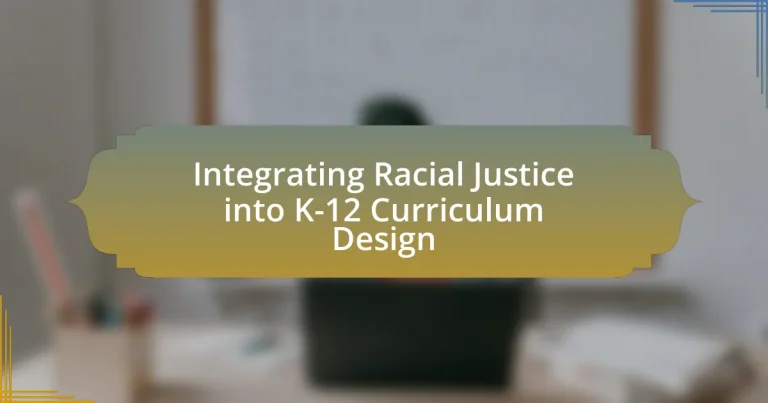Integrating racial justice into K-12 curriculum design involves incorporating diverse perspectives and histories of marginalized racial groups to create an inclusive educational environment. This approach addresses systemic inequalities and promotes equity, leading to improved student engagement and academic outcomes. The article explores the importance of racial justice in education, the historical context that necessitates it, and the principles of equity and inclusivity that should guide curriculum design. It also discusses the challenges educators face, strategies for effective integration, and the positive impacts on student learning and community cohesion.

What does integrating racial justice into K-12 curriculum design entail?
Integrating racial justice into K-12 curriculum design entails incorporating diverse perspectives, histories, and contributions of marginalized racial groups into educational content. This approach aims to create an inclusive learning environment that acknowledges systemic inequalities and promotes equity. For instance, research indicates that curricula reflecting diverse narratives can enhance student engagement and critical thinking, as evidenced by studies showing improved academic outcomes in schools that implement culturally relevant pedagogy. By embedding these elements, educators can foster a more equitable educational landscape that prepares students to understand and address social justice issues.
Why is racial justice important in K-12 education?
Racial justice is important in K-12 education because it ensures equitable access to educational resources and opportunities for all students, regardless of their racial or ethnic backgrounds. This focus on racial justice addresses systemic inequalities that have historically marginalized certain groups, leading to disparities in academic achievement and social outcomes. Research indicates that schools implementing racial justice frameworks see improved student engagement and performance, as well as a more inclusive school environment. For instance, a study by the National Education Association highlights that schools prioritizing equity in their curricula report higher graduation rates among students of color.
What historical context informs the need for racial justice in education?
The historical context that informs the need for racial justice in education includes systemic racism, segregation laws, and discriminatory practices that have marginalized students of color. For instance, the landmark Supreme Court case Brown v. Board of Education in 1954 declared racial segregation in public schools unconstitutional, highlighting the pervasive inequalities in educational access and quality. Additionally, the Civil Rights Movement of the 1960s brought attention to the disparities faced by African American students, leading to policies aimed at promoting equity. These historical events underscore the ongoing struggle for racial justice in education, as disparities in funding, resources, and opportunities continue to affect students of color today.
How does racial injustice impact student learning and outcomes?
Racial injustice significantly impairs student learning and outcomes by creating an environment of inequity that affects access to resources, quality of education, and overall academic performance. Students from marginalized racial backgrounds often face systemic barriers, such as underfunded schools, biased disciplinary practices, and lower expectations from educators, which contribute to achievement gaps. For instance, research from the National Center for Education Statistics indicates that schools serving predominantly Black and Hispanic students receive substantially less funding than those serving predominantly white students, leading to disparities in educational opportunities. Additionally, studies show that students who experience racial discrimination are more likely to report lower academic motivation and higher levels of stress, further hindering their educational success.
What are the key principles of racial justice in education?
The key principles of racial justice in education include equity, inclusivity, and anti-racism. Equity ensures that all students have access to the same educational opportunities, regardless of their racial or ethnic backgrounds. Inclusivity promotes a curriculum that reflects diverse perspectives and experiences, fostering a sense of belonging for all students. Anti-racism actively challenges and dismantles systemic racism within educational institutions, advocating for policies and practices that support marginalized communities. These principles are supported by research indicating that equitable educational practices lead to improved academic outcomes for students of color, as highlighted in studies by the National Education Association and the Education Trust.
How do equity and inclusion play a role in curriculum design?
Equity and inclusion are fundamental in curriculum design as they ensure that educational content is accessible and relevant to all students, regardless of their backgrounds. By incorporating diverse perspectives and addressing systemic inequalities, curriculum designers can create an environment that fosters belonging and engagement among all learners. Research indicates that inclusive curricula improve academic outcomes and social cohesion, as evidenced by a study from the National Education Association, which found that students exposed to diverse materials demonstrate higher critical thinking skills and empathy. Thus, prioritizing equity and inclusion in curriculum design not only enhances educational experiences but also promotes a more just society.
What are the core values that should guide racial justice education?
The core values that should guide racial justice education include equity, inclusivity, critical consciousness, and social responsibility. Equity ensures that all students have access to the same educational opportunities, regardless of their racial or ethnic backgrounds. Inclusivity fosters an environment where diverse perspectives are valued and represented, promoting a sense of belonging among all students. Critical consciousness encourages students to analyze and challenge systemic inequalities and injustices, empowering them to become active participants in social change. Social responsibility emphasizes the importance of community engagement and advocacy for justice, urging students to take action against discrimination and inequality. These values are essential for creating a curriculum that not only educates but also empowers students to contribute positively to a diverse society.
How can educators effectively integrate racial justice into their curriculum?
Educators can effectively integrate racial justice into their curriculum by incorporating diverse perspectives and historical contexts that highlight systemic inequalities and promote critical thinking. This can be achieved through the inclusion of texts and resources authored by people of color, discussions on historical events such as the Civil Rights Movement, and analysis of current social justice issues. Research indicates that curricula that reflect diverse voices not only enhance student engagement but also foster a deeper understanding of societal structures, as shown in studies like “Culturally Relevant Pedagogy: Ingredients for Critical Teacher Reflection” by Gloria Ladson-Billings, which emphasizes the importance of culturally relevant teaching in promoting equity.
What strategies can be employed to incorporate diverse perspectives?
To incorporate diverse perspectives in K-12 curriculum design, educators can implement strategies such as inclusive curriculum development, collaborative learning environments, and community engagement. Inclusive curriculum development involves integrating materials that reflect various cultures, histories, and viewpoints, ensuring representation of marginalized groups. Collaborative learning environments encourage students to share their experiences and perspectives, fostering dialogue and understanding among peers. Community engagement involves partnering with local organizations and diverse community members to provide real-world insights and resources, enhancing the curriculum’s relevance and depth. Research indicates that diverse curricula improve student engagement and academic performance, as seen in studies by the National Education Association, which highlight the benefits of culturally responsive teaching.
How can teachers assess the effectiveness of racial justice integration?
Teachers can assess the effectiveness of racial justice integration by utilizing student feedback, performance metrics, and classroom discussions. Collecting qualitative data through surveys and interviews allows educators to gauge students’ understanding and engagement with racial justice topics. Quantitative measures, such as analyzing test scores and participation rates in discussions related to racial justice, provide concrete evidence of learning outcomes. Additionally, observing changes in classroom dynamics and student interactions can indicate shifts in attitudes and awareness regarding racial justice issues. Research shows that when students feel their voices are heard and their experiences are validated, they demonstrate increased academic performance and social awareness, reinforcing the importance of effective integration of racial justice in the curriculum.

What challenges exist in integrating racial justice into K-12 curriculum design?
Integrating racial justice into K-12 curriculum design faces several challenges, including resistance from stakeholders, lack of resources, and insufficient teacher training. Resistance often stems from differing beliefs about the importance of racial justice in education, with some stakeholders fearing that it may lead to divisive or controversial discussions. Additionally, many schools lack the necessary resources, such as culturally relevant materials and funding, to effectively implement a curriculum that addresses racial justice. Furthermore, teachers often receive inadequate training on how to incorporate racial justice themes into their lessons, which can hinder their ability to engage students meaningfully on these topics. These challenges collectively impede the successful integration of racial justice into K-12 education.
What resistance might educators face when implementing racial justice principles?
Educators may face resistance from various stakeholders, including parents, administrators, and community members, when implementing racial justice principles. This resistance often stems from differing beliefs about race, equity, and the role of education in addressing social issues. For instance, some parents may oppose discussions on systemic racism, fearing it could lead to discomfort or conflict within their families. Administrators might hesitate to support such initiatives due to concerns about backlash or negative perceptions from the community. Additionally, educators themselves may experience internal resistance, feeling unprepared or lacking the necessary training to effectively teach these principles. Research indicates that these challenges can hinder the successful integration of racial justice into K-12 curricula, as seen in studies highlighting the importance of community buy-in and educator preparedness for fostering inclusive educational environments.
How can educators address misconceptions about racial justice in education?
Educators can address misconceptions about racial justice in education by implementing comprehensive, evidence-based curricula that accurately reflect historical and contemporary issues of racial inequality. This approach includes integrating diverse perspectives, utilizing primary sources, and fostering critical discussions that challenge stereotypes and promote understanding. Research indicates that when students engage with materials that represent multiple viewpoints, such as the work of scholars like Ibram X. Kendi and Robin DiAngelo, they develop a more nuanced understanding of systemic racism and its impact on society. Additionally, professional development for educators focused on anti-racist pedagogy can equip them with the tools necessary to confront and dispel misconceptions effectively.
What systemic barriers hinder the integration of racial justice?
Systemic barriers that hinder the integration of racial justice include entrenched educational inequities, lack of diverse representation in curriculum materials, and insufficient teacher training on racial issues. Educational inequities manifest in funding disparities, where schools in predominantly marginalized communities receive less financial support, leading to inadequate resources for teaching racial justice. The absence of diverse representation in curriculum materials limits students’ exposure to multiple perspectives, reinforcing a narrow understanding of history and social issues. Furthermore, many educators lack training in culturally responsive teaching practices, which is essential for effectively addressing racial justice in the classroom. These barriers collectively impede the meaningful incorporation of racial justice into K-12 education.
How can schools overcome these challenges?
Schools can overcome challenges in integrating racial justice into K-12 curriculum design by implementing comprehensive training programs for educators. These programs should focus on culturally responsive teaching methods and the historical context of racial issues, enabling teachers to effectively address and incorporate racial justice topics into their lessons. Research indicates that professional development in this area can lead to improved student engagement and understanding of racial equity, as evidenced by studies showing that schools with trained staff report higher levels of student awareness and sensitivity towards racial issues. Additionally, schools can collaborate with community organizations to provide resources and support, ensuring that the curriculum reflects diverse perspectives and experiences.
What role do professional development and training play in this process?
Professional development and training are essential for effectively integrating racial justice into K-12 curriculum design. These initiatives equip educators with the knowledge and skills necessary to understand and address systemic inequalities within educational frameworks. Research indicates that targeted professional development can lead to improved teaching practices, fostering an inclusive environment that reflects diverse perspectives. For instance, a study by the National Education Association found that teachers who participated in equity-focused training reported increased confidence in addressing issues of race and social justice in their classrooms. This evidence underscores the critical role that ongoing training plays in transforming educational practices to promote racial equity.
How can community involvement support racial justice initiatives?
Community involvement can significantly support racial justice initiatives by fostering collaboration between local organizations, schools, and families to create inclusive educational environments. Engaging community members in discussions and decision-making processes ensures that diverse perspectives are represented, which is crucial for developing a curriculum that accurately reflects the histories and contributions of various racial and ethnic groups. Research indicates that schools with strong community ties see improved student outcomes and increased awareness of social justice issues, as highlighted in the report “Community Engagement in Education: A Review of the Literature” by the National Education Association. This collaboration not only enhances the curriculum but also empowers students to become active participants in promoting racial equity within their communities.

What are the outcomes of successfully integrating racial justice into K-12 curriculum design?
Successfully integrating racial justice into K-12 curriculum design leads to enhanced student engagement, improved academic performance, and a more inclusive school environment. Research indicates that when students see their identities and histories reflected in the curriculum, they are more likely to participate actively in their education, which can result in higher grades and test scores. For instance, a study by the National Education Association found that culturally relevant pedagogy can increase student achievement and foster a sense of belonging among marginalized groups. Additionally, such integration promotes critical thinking and empathy, equipping students with the skills to navigate and challenge systemic inequalities in society.
How does racial justice integration benefit students and communities?
Racial justice integration benefits students and communities by fostering an inclusive educational environment that promotes equity and understanding. This integration enhances students’ critical thinking skills and cultural awareness, preparing them for a diverse society. Research indicates that schools implementing racial justice curricula see improved academic performance and reduced disciplinary issues among marginalized students, as evidenced by a study from the National Education Association, which found that inclusive curricula lead to higher engagement and lower dropout rates. Additionally, communities benefit from reduced racial tensions and increased social cohesion, as students who learn about racial justice are more likely to advocate for equity and inclusivity in their neighborhoods.
What improvements can be seen in student engagement and achievement?
Improvements in student engagement and achievement can be observed through the integration of racial justice into K-12 curriculum design. This approach fosters a more inclusive learning environment, which has been shown to enhance students’ sense of belonging and motivation. Research indicates that when students see their identities and histories reflected in the curriculum, they are more likely to participate actively in class discussions and collaborative projects. For instance, a study by the National Education Association found that culturally relevant pedagogy can lead to a 20% increase in student participation rates and a significant rise in academic performance, particularly among marginalized groups. This evidence supports the notion that integrating racial justice not only engages students but also improves their overall academic outcomes.
How does this integration foster a more inclusive school environment?
Integrating racial justice into K-12 curriculum design fosters a more inclusive school environment by promoting diverse perspectives and fostering empathy among students. This integration allows students to engage with a variety of cultural narratives, which helps to validate the experiences of marginalized groups and encourages respect for differences. Research indicates that inclusive curricula can lead to improved academic outcomes and social cohesion, as students learn to appreciate diversity and challenge stereotypes. For instance, a study by the National Education Association found that students exposed to multicultural education demonstrate higher levels of critical thinking and social awareness, reinforcing the importance of integrating racial justice into educational frameworks.
What best practices should educators follow for effective integration?
Educators should prioritize culturally responsive teaching as a best practice for effective integration of racial justice into K-12 curriculum design. This approach involves recognizing and valuing students’ diverse cultural backgrounds, which enhances engagement and learning outcomes. Research indicates that culturally responsive teaching can lead to improved academic performance and a more inclusive classroom environment, as evidenced by a study published in the “Journal of Educational Psychology” by Gay (2010), which highlights the positive impact of culturally relevant pedagogy on student achievement. Additionally, educators should incorporate critical discussions about race and social justice into the curriculum, fostering an environment where students can explore and challenge systemic inequalities. This practice not only promotes critical thinking but also empowers students to become active participants in social change.
How can educators create a culturally responsive curriculum?
Educators can create a culturally responsive curriculum by incorporating diverse perspectives and experiences into the learning materials and teaching practices. This involves recognizing and valuing the cultural backgrounds of all students, integrating relevant historical and contemporary issues that reflect their identities, and using inclusive teaching strategies that engage all learners. Research indicates that culturally responsive teaching improves student engagement and academic performance, as evidenced by a study published in the “Journal of Educational Psychology,” which found that students from diverse backgrounds performed better in classrooms where their cultural identities were acknowledged and integrated into the curriculum.
What resources are available to support racial justice education?
Resources available to support racial justice education include educational organizations, curriculum guides, and online platforms. Notable organizations such as Teaching Tolerance provide comprehensive resources, including lesson plans and professional development tools focused on equity and social justice. Additionally, the Zinn Education Project offers a wealth of teaching materials that emphasize the importance of diverse perspectives in history. Online platforms like Rethinking Schools publish books and articles that advocate for social justice education, providing educators with practical strategies to integrate these concepts into their classrooms. These resources are validated by their widespread use in K-12 education settings, demonstrating their effectiveness in promoting racial justice awareness among students.
What practical steps can educators take to begin integrating racial justice?
Educators can begin integrating racial justice by incorporating diverse perspectives into the curriculum. This involves selecting texts and materials that represent a variety of racial and cultural backgrounds, ensuring that students see themselves reflected in their learning. Research shows that inclusive curricula can improve student engagement and academic performance, particularly for marginalized groups. Additionally, educators should engage in professional development focused on racial equity, which equips them with the tools to address biases and foster an inclusive classroom environment. Implementing restorative justice practices can also promote a culture of respect and understanding among students, further supporting racial justice initiatives.


